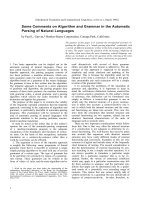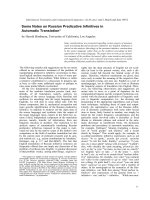Báo cáo toán học: " Some results on difference polynomials sharing values" doc
Bạn đang xem bản rút gọn của tài liệu. Xem và tải ngay bản đầy đủ của tài liệu tại đây (257.27 KB, 8 trang )
RESEARCH Open Access
Some results on difference polynomials sharing
values
Yong Liu
1,2
, XiaoGuang Qi
3*
and Hongxun Yi
1
* Correspondence:
3
Department of Mathematics, Jinan
University, Jinan 250022,
Shandong, P. R. China
Full list of author information is
available at the end of the article
Abstract
This article is devoted to studying uniqueness of difference polynomials sharing
values. The results improve those given by Liu and Yang and Heittokangas et al.
1 Introduction and main results
In this ar ticle, we shall assume that the reader is familiar with the fundamental results
and the standard notations of the Nevanlinna theory (e.g., see [1-3]). In addition, w e
will use the notations l(f) to denote the exponent of convergence of zero sequences of
meromorphic function f(z); s(f) to denote the order of f (z). We say that meromorphic
functions f and g shareafinitevalueaCMwhen f - a and g - a havethesamezeros
with the same multiplicities. For a non-zero constant c,theforwarddifference
n+1
c
f (z)=
n
c
f (z + c) −
n
c
f (z)
,
n+1
c
f (z)=
n
c
f (z + c) −
n
c
f (z)
, n = 1, 2, In gen-
eral, we use the notation C to denote the field of complex numbers.
Currently, there has been an increasing interest in studying difference eq uations in
the complex plane. Halburd and Korhonen [4,5] established a version of Nevanlinna
theory based on difference operators. Ishizaki and Yanagihara [6] developed a version
of Wiman-Valiron theory for difference equations of entire functions of small growth.
Recently, Liu and Yang [7] establish a counterpart result to the Brück conjecture [8]
valid for transcendental entire function for which s(f) <1. The result is stated as
follows.
Theorem A. Let f be a transcendental entire function such that s(f) <1. If f and
n
c
f
share a finite value a CM, n is a positive integer, and c is a fixed constant, then
n
c
f − a
f − a
= τ
for some non-zero constant τ.
Heittokangas et al. [9], prove the following result which is a shifted analogue of
Brück conjecture valid for meromorphic functions.
Theorem B. Let f be a meromorphic function of order of growth s(f) <2, and let c Î
C. If f(z) and f(z + c) share the values a Î C and ∞ CM, then
f (z + c) − a
f (z) − a
= τ
Liu et al. Advances in Difference Equations 2012, 2012:1
/>© 2012 Liu et al; licensee Springer. This is an Open Access article distributed und er the t erms of the Creative Commons Attributi on
License ( 2.0), which permits unrestricted use, distribution, a nd reproduction in any medium,
provided the original work is properly cited.
for some constant τ.
Here, we also study the shift analo gue of Br ück conjecture, and obtain the results as
follows.
Theorem 1.1. Let f(z) be a non-constant entire function, s(f) <1 or 1 < s(f) <2 and l
(f) < s(f)=s. Set L
1
(f)=a
n
(z) f(z + n)+a
n-1
(z) f(z + n - 1) + + a
1
(z) f(z +1)+a
0
(z)
f(z),wherea
j
(z)(0 ≤ j ≤ n) areentirefunctionswitha
n
(z)a
0
(z) ≢ 0. Suppose that if s(f)
<1, then max{s(a
j
)} = a <1, and if 1 < s(f) <2, then max{s(a
j
)} = a < s -1. If f and L
1
(f) share 0 CM, then
L
1
(f )=cf ,
where c is a non-zero constant.
Theorem 1.2. Let f(z) be a non-constant entire function,2< s(f) <∞ and l(f) < s(f).
Set L
2
(f) = a
n
(z) f(z + n)+a
n-1
(z) f(z + n-1) + + a
1
(z) f(z +1)+e
z
f(z),a
j
(z)(1 ≤ j ≤
n) are entire functions with s(a
j
) <1 and a
n
(z) ≢ 0. If f and L
2
(f ) share 0 CM, then
L
2
(f )=h(z)f ,
where h(z) is an entire function of order no less than 1.
Theorem 1.3. Let f(z) be a non-constant entire function, s(f) <1 or 1 < s(f) <2, l(f) <
s(f). Set L
3
(f)=a
n
(z) f(z + n)+a
n-1
(z) f(z + n-1) + + a
1
(z) f(z +1)+a
0
(z) f(z),a
j
(z)
(0 ≤ j ≤ n) are polynomials and a
n
(z) ≢ 0.IffandL
3
(f ) share a polynomial P(z) CM,
then
L
3
(f ) − p(z)=c(f(z) − p(z)),
where c is a non-zero constant.
Theorem 1.4. Let f(z) be a non-constant entire function, s(f) <1 or 1 < s(f) <2, l(f) <
s(f). Set a(z) is an entire function with s(a) <1. If f and a(z)f(z + n) share a polynomial
P(z) CM, then
a(z)f (z + n) − p(z)=c(f (z) − p(z)),
where c is a non-zero constant.
The method of the article is partly from [10].
2 Preliminary lemmas
Lemma 2.1. [11]Let f(z) be a meromorphic function w ith s(f)=h <∞. Then for any
given ε >0, there is a set E
1
⊂ (1, +∞) that has finite logarithmic measure, such that
|f (z)|≤exp{r
η+ε
},
holds for |z|=r ∉ [0, 1] ∪ E
1
, r ® ∞.
Applying Lemma 2.1 to
1
f
, it is easy to see that for any given ε >0, there is a set E
2
⊂
(1, ∞) of finite logarithmic measure, such that
exp{−r
η+∈
}≤ |f (z)|≤exp{r
η+ε
},
holds for |z|=r ∉ [0, 1] ∪ E
2
, r ® ∞.
Lemma 2.2. [11]Let
Q(z)=b
n
z
n
+ b
n−1
z
n−1
+ ···+ b
0
,
Liu et al. Advances in Difference Equations 2012, 2012:1
/>Page 2 of 8
where n is a positive integer and
b
n
= α
n
e
iθ
n
, α
n
> 0, θ
n
∈ [0, 2π)
. For any given
ε(0 <ε<
π
4n
)
, we introduce 2n open sectors
S
j
: −θ
n
+(2j − 1)
π
2n
+ ε<θ<−θ
n
+(2j +1)
π
2n
− ε(j =0,1, ,2n − 1).
Then there exists a positive number R = R(ε) such that for |z|=r>R,
Re{Q(z)} >α
n
(1 − ε)sin(nε)r
n
if z Î S
j
where j is even; while
Re{Q(z)} < −α
n
(1 − ε)sin(nε)r
n
if z Î S
j
where j is odd.
Now for any given θ Î [0, 2π),if
θ = −
θ
n
n
+(2j − 1)
π
2n
,(j = 0, 1, , 2n-1), then we
take ε sufficiently small, there is some S
j
, j Î {0, 1, ,2n-1} such that θ Î S
j
.
Lemma 2.3. [12]Let f(z) be a meromorphic funct ion of orde r s = s( f) <∞, and let l’
and l’’ be, respectively, the exponent of convergence of the zeros and poles of f. Then for
any given ε >0, there exists a set E ⊂ (1, ∞) of |z|=r of finite logarithmic measure, so
that
2πin
z,η
+log
f (z + η)
f (z)
= η
f
(z)
f (z)
+ O(r
β+ε
),
or equivalently,
f (z + η)
f (z)
= e
η
f
(z)
f (z)
+O(r
β+ε
)
,
holds for r ∉ E ∪ [0, 1], where n
z,h
is an integer depending on both z and h, b =max
{s - 2, 2l -2}if l <1 and b = max{s - 2, l - 1} if l ≥ 1 and l = max{l’, l’’}.
Lemma 2.4.[2]Let f(z) be an entire function of order s, then
σ = lim sup
r→∞
log ν(r)
log r
where ν(r) be the central index of f.
Lemma 2.5. [2,13,14]Let f be a transcendental entire function, let
0 <δ<
1
4
and z be
such that |z|=r and that
|f (z)| > M(r, g)ν(r, g)
−
1
4
+δ
holds. Then there exists a set F ⊂ R
+
of finite logarithmic measure, i.e.,
F
dt
t
< ∞
,
such that
f
(m)
(z)
f (z)
=
ν(r, f )
z
m
(1 + o(1))
holds for all m ≥ 0 and all r ∉ F.
Lemma 2.6.[10]Let f(z) be a transcendental entire function, s(f)=s <∞,andG=
{ω
1
, ω
2
, , ω
n
}, and a set E ⊂ (1, ∞) having logarithmic measure lmE <∞. Then there is
Liu et al. Advances in Difference Equations 2012, 2012:1
/>Page 3 of 8
a positive number
B(
3
4
≤ B ≤ 1)
,apointrange
{z
k
= r
k
e
iω
k
}
such that |f(z
k
)| ≥ BM(r
k
, f
), ω
k
Î [0, 2π), lim
k®∞
ω
k
= ω
0
Î [0, 2π), r
k
∉ E ∪ [0, 1], r
k
® ∞, for any given ε >0,
we have
r
σ −ε
k
<ν(r
k
, f ) < r
σ +ε
k
.
3 Proof of Theorem 1.1
Under the hypothesis of Theorem 1.1, see [3], it is easy to get that
L
1
(f )
f
= e
Q(z)
,
(3:1)
where Q(z) is an entire function. If s( f ) <1, we get Q(z) is a constant. Then Theorem
1.1 holds. N ext, we suppose that 1 < s(f) <2andl(f ) < s(f)=s. We divide this into
two cases (Q(z) is a constant or a polynomial with deg Q = 1) to prove.
Case (1): Q(z) is a constant. Then Theorem 1.1 holds.
Case (2): deg Q = 1. By Lemma 2.3 and l(f) < s(f)=s,foranygiven
0 <ε<min{
σ −1
2
,
1−α
2
,
σ −λ(f)
2
,
σ −1−α
2
}
, there exists a set E
1
⊂ (1, ∞)of|z|=r of finite
logarithmic measure, so that
f (z + j)
f (z)
= exp
j
f
(z)
f (z)
+ o(r
σ (f)−1−ε
)
, j =1,2, , n
(3:2)
holds for r ∉ E
1
∪ 0[1].
By Lemma 2.5, there exists a set E
2
⊂ (0, ∞) of finite logarithmic measure, such that
f
(z)
f (z)
=(1+o(1))
ν(r, f )
z
,
(3:3)
holds for |z|=r ∉ E
2
∪ [0, 1], where z is chosen as in Lemma 2.5.
By Lemma 2.1, for any given ε > 0, there exists a set E
3
⊂ (1, ∞) that has finite loga-
rithmic measure such that
exp{−r
α+ε
}≤ |a
j
(z)|≤exp{r
α+ε
}(j =0,1, , n)
(3:4)
holds for |z|=r ∉ [0, 1] ∪ E
3
, r ® ∞.
Set E = E
1
∪E
2
∪E
3
and
G = {−
ϕ
n
n
+(2j − 1)
π
2n
|j =0,1}∪{
π
2
,
3π
2
}
. By Lemma 2.6, there
exist a positive number
B ∈ [
3
4
,1]
, a point range
{z
k
= r
k
e
iθ
k
}
such that |f(z
k
)| ≥ BM (r
k
,
f], θ
k
Î [0, 2π), lim
k®∞
θ
k
= θ
0
Î [0, 2π)\G, r
k
∉ E ∪ [0, 1], r
k
® ∞, for any given ε
>0, as r
k
® ∞, we have
r
σ (f)−ε
k
<ν(r
k
, f ) < r
σ (f)+ε
k
(3:5)
By (3.1)-(3.3), we have that
a
n
exp
n(1 + o(1))
ν(r
k
, f )
z
k
+ ···+ a
1
exp
(1 + o(1))
ν(r
k
, f )
z
k
} + a
0
= e
Q(z)
(3:6)
Let
Q(z)=τ e
iθ
1
z + b
0
, τ >0, θ
1
Î [0, 2π). By Lemma 2.4, there are two opened angles
for above ε,
Liu et al. Advances in Difference Equations 2012, 2012:1
/>Page 4 of 8
S
j
: −θ
1
+(2j − 1)
π
2
+ ε<θ<−θ
1
+(2j +1)
π
2
+ ε(j =0,1)
For the above θ
0
, there are two cases: (i) θ
0
Î S
0
; (ii) θ
0
Î S
1
.
Case (i). θ
0
Î S
1
.SinceS
j
is an opened set and lim
k®∞
θ
k
= θ
0
,thereisaK>0 such
that θ
k
Î S
j
when k>K. By Lemma 2.2, we have
Re{Q(r
k
e
iθ
k
)} < −ηr
k
,
(3:7)
where h = h(1 - ε)sin(ε) >0. By Lemma 2.2, if Rez
k
> ζr
k
(0 < ζ ≤ 1). By (3.4)-(3.7),
we have
exp{r
σ (f)−1−ε
k
− r
α+ε
k
}
≤
a
n
exp
n(1 + o(1))
ν(r
k
, f )
z
k
≤ 3
a
n
exp
n(1 + o(1))
ν(r
k
, f )
z
k
+ ···+ a
1
exp{(1 + o(1))
ν(r
k
, f )
z
k
} + a
0
=3
e
Q(z)
≤ 3e
−ηr
k
,
(3:8)
which contradicts that 0 < s(f) - 1 - a - ε.
If Rez
k
<-ζr
k
(0 < ζ ≤ 1), By (3.4)-(3.7), we have
1 ≤
a
n
a
0
exp
n(1 + o(1))
ν(r
k
, f )
z
k
+ ···+
a
1
a
0
exp
(1 + o(1))
ν(r
k
, f )
z
k
+
e
Q(z)
a
0
≤ 2n exp
−ηr
σ (f )−1+ε
k
+2r
α+ε
k
+ e
−ηr
k
exp {r
α+ε
k
},
(3:9)
which implies that 1 <0, r ® ∞, a contradiction.
Case (ii). θ
0
Î S
0
.SinceS
0
is an opened set and lim
k®∞
θ
k
= θ
0
,thereisK>0such
that θ
k
Î S
j
when k>K. By Lemma 2.2, we have
Re{Q(r
k
e
iθ
k
)} >ηr
k
,
(3:10)
where h = τ(1 - ε) sin(ε) > 0. By (3.4)-(3.6), (3.9), we obtain
(n + 1) exp{nr
σ (f )−1+ε
k
+ r
α+ε
k
}
≥|a
n
exp{n(1 + o(1))
ν(r
k
, f )
z
k
} + ···+ a
1
exp{(1 + o(1))
ν(r
k
, f )
z
k
} + a
0
|
= |e
Q(z)
|≥e
ηr
k
.
(3:11)
From (3.11), we get that s(f) ≥ 2, a contradiction. Theorem 1.1 is thus proved.
4 Proof of Theorem 1.2
Under the hypothesis of Theorem 1.2, see [3], it is easy to get that
L
2
(f )
f
= e
Q(z)
,
(4:1)
where Q(z) is an entire function. For Q(z), we discuss the following two cases.
Case (1): Q(z) is a polynomial with deg Q = n ≥ 1. Then Theorem 1.2 is proved.
Case (2): Q(z) is a constant. Using the similar reasoning as in the proof of Theore m
1.1, we get that
Liu et al. Advances in Difference Equations 2012, 2012:1
/>Page 5 of 8
a
n
exp
n(1 + o(1))
ν(r
k
, f )
z
k
+ ···+ a
1
exp
(1 + o(1))
ν(r
k
, f )
z
k
+ a = −e
z
k
,
(4:2)
where a is some non-zero constant.
If Rez
k
<-hr
k
(hÎ(0, 1]), By (3.4), (3.5), (4.2), we have
|a|≤
a
n
exp
n(1 + o(1))
ν(r
k
, f )
z
k
+ ···+ a
1
exp
(1 + o(1))
ν(r
k
, f )
z
k
+ | exp{z
k
}|
≤ exp{−ηr
k
} + n exp{−ηr
σ (f )−1+ε
k
+2r
α+ε
k
},
(4:3)
which is impossible.
If Rez
k
> hr
k
(h Î (0, 1]), By (3.4), (3.5) and (4.2), we get
exp
ηr
σ (f )−1−ε
k
< exp
n
ν(r
k
, f )
z
k
− r
α+ε
k
≤ 2
a
n
exp
n(1 + o(1))
ν(r
k
, f )
z
k
+ ···+ a
1
exp
(1 + o(1))
ν(r
k
, f )
z
k
+ a
=2|−exp{z
k
}| ≤ 2 exp{r
k
},
(4:4)
which contradicts that s(f) >2. This completes the proof of Theorem 1.2.
5 Proof of Theorem 1.3
Since f and L
3
(f) share P CM, we get
L
3
(f )
f
= e
Q(z)
,
(5:1)
where Q(z) is an entire function. If s( f ) <1, we get Q(z) is a constant. Then Theorem
1.3 holds. Next, we s uppose that 1 < s(f) <2andl(f) < s(f)=s.SetF(z)=f(z) -P(z),
then s(F)=s(f). Substituting F(z)=f(z) -p(z) into (5.1), we obtain
a
n
(z)F ( z + n)+a
n−1
(z)F ( z + n − 1) + ···+ a
1
(z)F ( z +1)
F(z)
+ a
0
(z)+
b(z)
F(z)
= e
Q(z)
,
(5:2)
where b(z)=a
n
(z) P(z + n)+ + a
1
(z) P (z +1)+a
0
(z) p(z) is a polynomial. We dis-
cuss the following two cases.
Case 1. Q(z) is a complex constant. Then Theorem 1.3 holds.
Case 2. Q(z) is a polynomial with deg Q = 1. By Lemma 2.3 and l(f) < s(f)=s,for
any given
0 <ε<min{
σ −1
2
,
1−α
2
,
σ −λ(f )
2
,
σ −1−α
2
}
,thereexistsasetE
1
⊂ (1, ∞)of|z|=
r of finite logarithmic measure, so that
f (z + j)
f (z)
= exp{j
f
(z)
f (z)
+ o(r
σ (f )−1−ε
)}, j =1,2, , n
(5:3)
holds for r ∉ E
1
∪ [0, 1].
By Lemma 2.5, there exists a set E
2
⊂ (0, ∞) of finite logarithmic measure, such that
f
(z)
f (z)
=(1+o(1))
ν(r, f )
z
,
(5:4)
holds for |z|=r ∉ E
2
∪ [0, 1], where z is chosen as in Lemma 2.5.
Liu et al. Advances in Difference Equations 2012, 2012:1
/>Page 6 of 8
Set E = E
1
∪ E
2
and
G = {−
ϕ
n
n
+(2j − 1)
π
2n
|j =0,1}∪{
π
2
,
3π
2
}
. By Lemma 2.6, there
exist a positive number
B ∈ [
3
4
,1]
,apointrange
{z
k
= r
k
e
iθ
k
}
such that | f (z
k
)| ≥ BM
(r
k
, f), θ
k
Î [0, 2π), lim
k®∞
θ
k
= θ
0
Î [0, 2π)\G, r
k
∉ E ∪ 0[1], r
k
® ∞, for any given ε
>0, as r
k
® ∞, we have
r
σ (f )−ε
k
<ν(r
k
, f ) < r
σ (f )+ε
k
.
(5:5)
Since F is a transcendental entire function and |f(z
k
)| ≥ BM (r
k
, f), we obtain
b(z
k
)
F( z
k
)
→ 0, (r
k
→∞).
(5:6)
By (5.2)-(5.6), we have that
a
n
exp
n(1 + o(1))
ν(r
k
, f )
z
k
+ ···+ a
1
exp
(1 + o(1))
ν(r
k
, f )
z
k
+ a
0
+ o(1) = e
Q(z)
.
(5:7)
Using similar p roof as in proof of Theorem 1.1, we ca n get a contradiction. Hence,
Theorem 1.3 holds.
6 Proof of Theorem 1.4
Using similar proof as in proof of Theorem 1.1, we can get Theorem 1.4 holds.
Acknowledgements
The authors thank the referee for his/her valuable suggestions to improve the present article. This research was partly
supported by the NNSF of China (No. 11171184), the NSF of Shangdong Province, China (No. Z2008A01) and
Shandong University graduate student independent innovation fund (yzc11024).
Author details
1
Department of Mathematics, Shandong University, Jinan 250100, Shandong, P. R. China
2
Department of Physics and
Mathematics, Joensuu Campus, University of Eastern Finland, P.O. Box 111, Joensuu FI-80101, Finland
3
Department of
Mathematics, Jinan University, Jinan 250022, Shandong, P. R. China
Author's contributions
YL completed the main part of this article, YL, XQ and HX corrected the main theorems. All authors read and
approved the final manuscript.
Competing interests
The authors declare that they have no competing interests.
Received: 9 June 2011 Accepted: 5 January 2012 Published: 5 January 2012
References
1. Hayman, W: Meromorphic Functions. Clarendon Press, Oxford (1964)
2. Laine, I: Nevanlinna Theory and Complex Differential Equations. Walter de Gruyter, Berlin (1993)
3. Yang, CC, Yi, HX: Uniqueness of Meromorphic Functions. Kluwer, Dordrecht (2003)
4. Halburd, RG, Korhonen, R: Difference analogue of the lemma on the logarithmic derivative with applications to
difference equatons. J Math Appl. 314, 477–487 (2006)
5. Halburd, RG, Korhonen, R: Nevanlinna theory for the difference operator. J Ann Acad Sci Fenn Math. 94, 463–478 (2006)
6. Ishizaki, K, Yanagihara, N: Wiman-Valiron method for difference equations. Nagoya Math J. 175,75–102 (2004)
7. Liu, K, Yang, LZ: Value distribution of the difference operator. Arch Math. 92, 270–278 (2009). doi:10.1007/s00013-009-
2895-x
8. Brück, R: On entire functions which share one value CM with their first derivatives. Result Math. 30,21–24 (1996)
9. Heittokangas, J, Korhonen, R, Laine, I, Rieppo, J, Zhang, JL: Value sharing results for shifts of meromorphic function, and
sufficient conditions for periodicity. J Math Anal Appl. 355, 352–363 (2009). doi:10.1016/j.jmaa.2009.01.053
10. Li, S, Gao, ZS: A note on the Brück conjecture. Arch Math. 95, 257–268 (2010). doi:10.1007/s00013-010-0165-6
11. Markushevich, AI: Theory of Functions of a Complex Variable, vol. 2, translated by Silverman RA. Prentice-Hall,
Englewood Cliffs, NJ. (1965)
12. Chiang, YM, Feng, SJ: On the growth of logarithmic differences, difference equotients and logarithmic derivatives of
meromorphic functions. Trans Am Math Soc. 361(7), 3767–3791 (2009). doi:10.1090/S0002-9947-09-04663-7
Liu et al. Advances in Difference Equations 2012, 2012:1
/>Page 7 of 8
13. Chen, ZX: The zero, pole and order meromorphic solutions of differential equations with meromorphic coefficents.
Kodai Math J. 19, 341–354 (1996). doi:10.2996/kmj/1138043651
14. Jank, G, Volkmann, L: Meromorphe Funktionen und Differentialgleichungen. Birkhäuser, Basel (1985)
doi:10.1186/1687-1847-2012-1
Cite this article as: Liu et al.: Some results on difference polynomials sharing values. Advances in Difference
Equations 2012 2012:1.
Submit your manuscript to a
journal and benefi t from:
7 Convenient online submission
7 Rigorous peer review
7 Immediate publication on acceptance
7 Open access: articles freely available online
7 High visibility within the fi eld
7 Retaining the copyright to your article
Submit your next manuscript at 7 springeropen.com
Liu et al. Advances in Difference Equations 2012, 2012:1
/>Page 8 of 8









